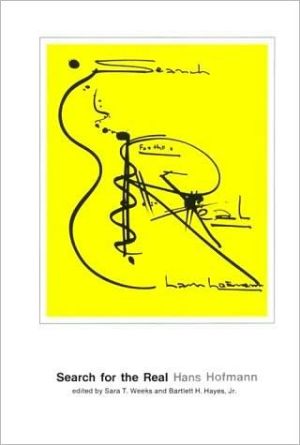

 |

|

The average rating for Search for the Real and Other Essays based on 2 reviews is 5 stars.
Review # 1 was written on 2007-08-15 00:00:00 Shih-wen Chang Shih-wen Chang--- Read this and more reviews of Philosophy books on the History page of www.BestPhilosophyBooks.org (a thinkPhilosophy Production). --- Hans Hofmann, artist and philosopher, developed and wrote about how to create volume and depth through the push and pull between colors and forms on a two dimensional plane. Hofmann theorizes the difference between the *representation* of volume and depth through the pictorial use of lines -- such as with receding horizons -- and the activation? of depth and volume that emerges as an interval-space of relationship between elements on a two dimensional canvas. That was a mouthful, I know..... The difference is between the representation of three dimensionality on two dimensions (where these two orientations towards what is seen are in tension), and the creation of three dimensions within the limit of two -- that which supports the magical in visual art. In effect, what he theorized was the possibility of the infinite embedded in the finite. Think of it like the facing off of two mirrors, only the effect is no surface effect.... Underlying these are two competing notions of space -- what Aristotle named the extended envelope or place (Hofmann and others call it positive space) and the interval that emerges as the (negative) space between things. [Who was it that said that if what you wish to capture is the beauty of the rose, what you must paint is the space all around it -- therein lies the dynamism (dunamis, or power) of the seen as the integration of feeling and form.] Extended space as place becomes the basis for modern conceptions of space/place; it is the basis both for Cartesian res extensa and the matrix model assumed by the natural sciences. What is the relationship between these two "kinds" of space? Could it be that there have been two different and separate things that we call space? Are these two competing and antagonistic, or do they (in the end, qua opposites) act in concert? Or, another possibility again, does the one act as the support for the other? Is the interval-space (by far the most archaic of spaces, going back to pre-Greek, Orphic cults) the support on which the idea of a stable matrix spatiality rests? If so, then maybe it is not a matter of two separate and distinct spaces, but of scale, of two modes of one same phenomena. --- Read this and more reviews of Philosophy books on the History page of www.BestPhilosophyBooks.org (a thinkPhilosophy Production). --- |
Review # 2 was written on 2008-10-11 00:00:00 Jeffrey Paskar Jeffrey PaskarLife-changing. |
CAN'T FIND WHAT YOU'RE LOOKING FOR? CLICK HERE!!!